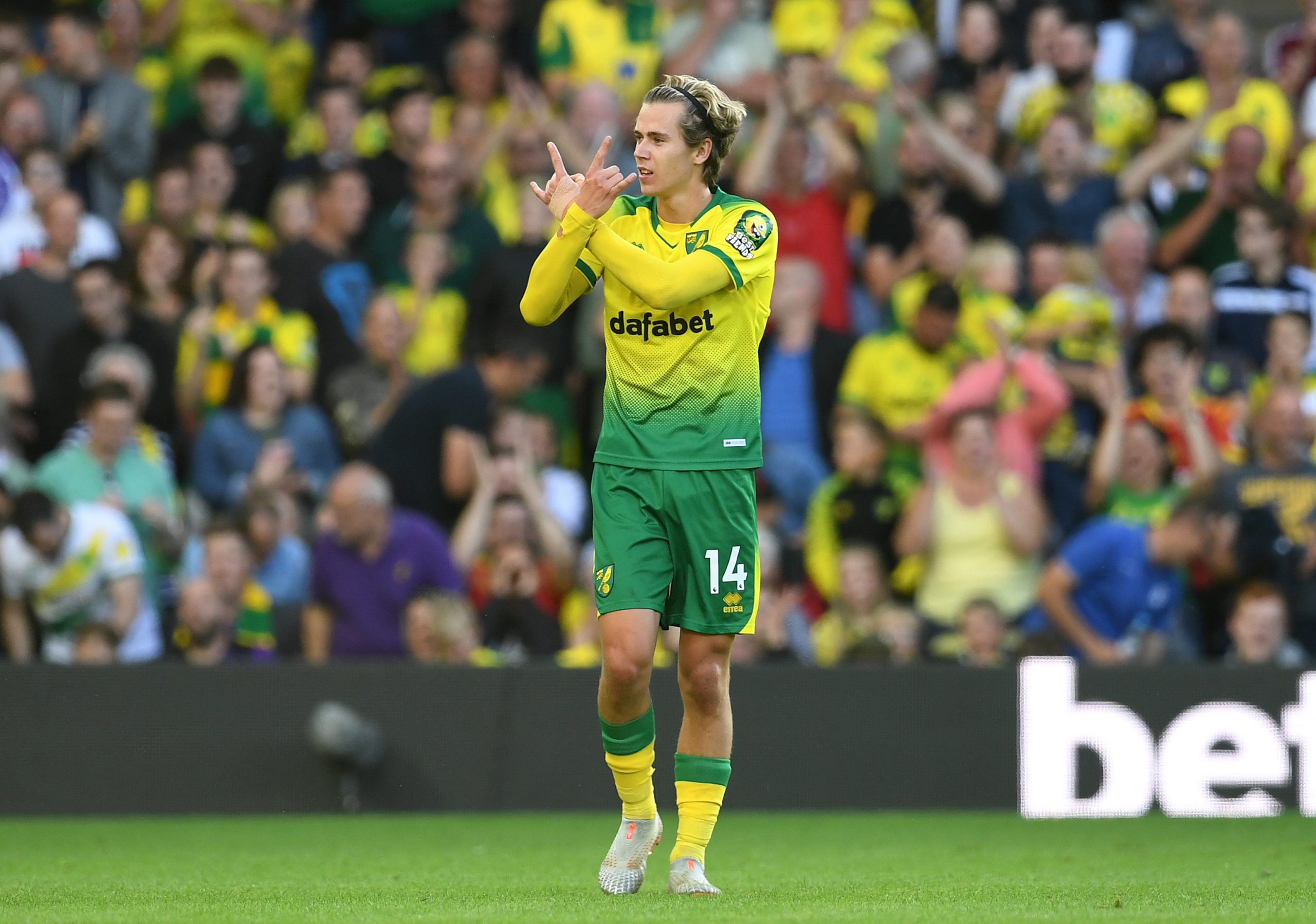Todd Cantwell has hardly ventured outside of his local club Norwich City. Coming up through the ranks, and with a brief loan spell with Fortuna Sittard back in 2017, last season’s #36 – this season’s #14 – has managed to break into the first team and make a name for himself, first in head coach Daniel Farke’s eyes, and then against Manchester City, the world's.
After a thoroughly impressive start to the Premier League season, raking in four combined goals and assists (two of each) and putting in a top-tier performance to kick off the season at Anfield, why has his name barely been mentioned before? He's 21, English and an attacker. He should be on the tip of peoples’ tongues by now. But, after recording a measly total of three combined goals and assists in just short of 1800 minutes last season, you can start to see why he wasn’t.
So, has this fast return on the goal-front been coming, or is it merely a hot streak? With my curiosity piqued, I decided to take a deeper dive into Todd Cantwell and find out for sure whether he deserves more credit than he seems to have been given.
Offensive game
Positioning and movement
In his time with Fortuna, he played a variety of roles, all of which were very loose and unrestrictive. At first, he was used out wide on either side before being brought into the centre of midfield shortly after.
What has been most impressive about him in these freer roles – which he has also been given under Farke at Norwich – is the intelligence in his movement and positioning. Cantwell seems to have a sixth sense that was present from day one. He can do it all: collecting from the centre backs, offering between the lines, and making runs into depth, and all with relentless intensity. In both setups, he was allowed to move freely up, down and across the pitch. And, in such possession-oriented sides, the importance of the attackers’ movements are pivotal.
If he had one shortcoming in his movement it's that he would ocasionally drop too deep, butit’s been something which he’s majorly improved upon since getting starts for Norwich. The clips below highlight a handful of the kinds of mistakes he's quickly ironing out of his game, such as laying it off straight and not moving for the ball, and also dropping between the centre backs when it wasn’t necessary.
In the first team setup with Norwich, it, initially, seemed like his persistent left-midfield role might overly restrict him and negate his qualities, but that was far from the case. As you can see here, his movement to offer frequently, and at different angles, helps to recycle play and maintain tempo, as well as open lanes into others ahead of him and stretch the play with longer passes.
Between the opposition’s defence and midfield, his movement has also been exceptionally good. Under Farke, the dynamism and variety of his movement increased and he not only made darting runs across that line to exchange positions and receive in good areas, but also moved heavily across to the ball-side, which was typically down Norwich’s right.
His ability to support from left to right played a big part in Farke’s use of the 4-2-3-1 and his emphasis on close, combinative play. Cantwell started high and narrowly across on his left side before moving across into positions usually deep of Teemu Pukki, but he also offered in line with the holding midfielder at times to create a different angle for the ball-holders. When he was just deep of Pukki, though, he made himself available between the lines, and was a viable option to bounce passes off, which Emi Buendía frequently looked to do. His unrelenting movement in these areas also sees him take up a number of great attacking positions in the channels. He' lightning fast to exploit spaces left by Pukki, be it in behind or in the halfspaces.
Receiving the ball
The issue here, though it has improved over time, is that Cantwell rarely ever received on the half-turn; he was always ball-facing. This already put him at a disadvantage in terms of being fully aware of where the spaces were behind him, where his opponents were and where the next pass was.Add to this the fact that he often took on the ball with the wrong side of his body since he’s not someone who prefers to shield the ball past players, and you have a very unproductive combo.
What he’ll often do, particularly when receiving from the left, is take the first touch facing the near-sided flank, narrowing his angles. This, in his Fortuna days, was made worse by how little he scanned for opponents before coming to the ball, so he would end up controlling it in the opposite way he should have. He would also often intercept the path of the ball too early, meaning he had to take even more touches to rotate fully.
There is still reason for optimism, though, as he has this season not just shown a far greater level of awareness for his opponents – constantly checking over both shoulders at all times – but he has also improved the number of times he’ll use a completely open body when receiving. Unfortunately, his receiving on the right is still as limited as before, which is even worse as he isn’t comfortable enough to open up his body onto his weaker side. It’s part of the reason why he pretty much has to play from the left since on the right he gets stuck in a rut of making rotations for his wide teammates, but not adding much else to the attack.
Below is a comparison of two home games – Rotherham United (left) and Reading (right). These action maps, comparing two separate games, illustrate that his actions are far more widespread when starting from the left than on the right. The only reason for the increased volume against Reading was because Norwich generally prefers to build through there in the middle third.
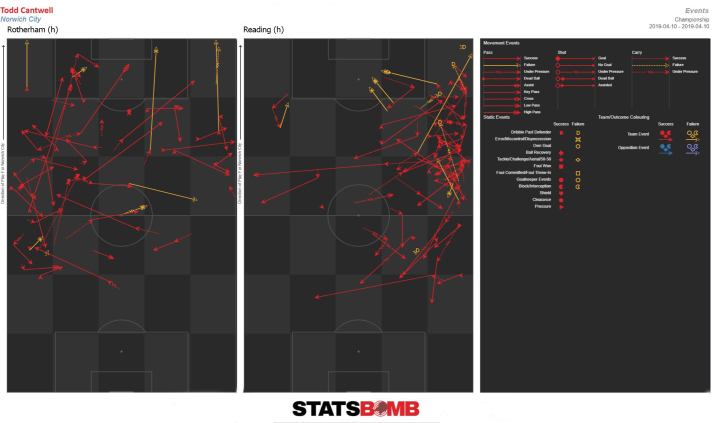
In the end, Cantwell was a victim of circumstance last season. Off the back of some great form playing on the left, he was forced to play on the right, which saw his form subsequently dip, as well as his minutes.
Touch, control and dribbling
His overall control of the ball in tight spaces is significantly better than his first touch. Despite his awareness issues, his improvisation on the spot and his ability to turn so sharply, albeit one-footed, is wonderful.
The drawback of being so one-footed, however, is that he can often be let down by weaker foot touches with the way he dribbles. He shows the ball on his outside, where his body isn’t already across it, so one stray touch can easily give it away.
While he is not so good in isolated wide one-on-one’s, he’s great at accelerating with the ball inside. Despite this openness in his ball-carrying, the invited pressure means that when jinxes narrowly further inside, he can beat the challenge he lured with relative ease. As can be seen in the examples below, even when cutting in, he isn’t actually using the inside of his body to muscle off opponents.
Passing and awareness
Obviously, all of his movements are hugely important but there are limitations if you can’t do anything with it. So, how is he once he gets the ball? At times, he’s brilliant in his range of passes, other times, he’s wasteful and not quick enough to recognise openings.
When he plays on the left, his range of passes has increased, as cutting in means he instantly has a wide-open space to analyse. In his best 18/19 performances, he was able to pick up the ball in a very deep position and play incisive passes through the lines.
Here we can see specific middle third buildup zones in either halfspace. The left-sided graphic is from the beginning of the season up until Christmas while post-Christmas until the end of the season is on the right. These time periods correspond with the periods in which he played on either side.
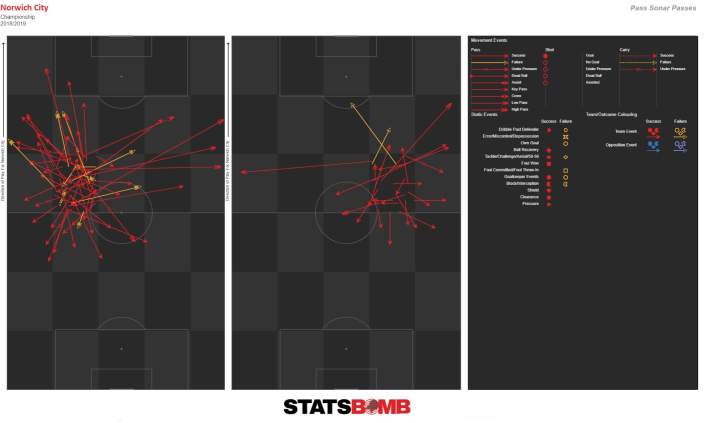
His speed of thought, albeit inconsistent, can be a strong point of his – knowing when and how to play first-time passes, and usually valuable ones into the channels. It is, however, vitally important you can also scan for the larger picture, which is something he doesn’t always do, and this affects the heights his vision can reach, at least when he doesn’t have time on his side. And, what doesn’t help his case, is his execution of passes in attacking transitions, which can be inconsistent, and needs to improve in order to assist more chances.
What is especially impressive, though, is how often, especially this season, he instigates combinations to avoid pressure and progress into the middle up and down the pitch. Not only is the frequency helpful, but how he will fractionally adjust his touches and body shape to maximise the space he has to receive the return.
Awareness in attack
The issue of vision and awareness, unfortunately, stretches into his attacking movement. Although I’ve praised this side of his game already, there is a bit of distinction between noticing a channel to attack right next to you and how to move in bigger, more open spaces by your own accord.
Without natural striker instincts, he often finds himself waiting for the cutback, rather than getting across the face of goal.
It might explain why he only netted once last season with that one, of course, being from a cutback. Still, there were times, especially when Pukki had vacated the box, when he should’ve been busting a gut to make a run to the front. Here against Reading we see Cantwell hanging off the back of the defence awaiting a cutback when he should attack the face of goal.
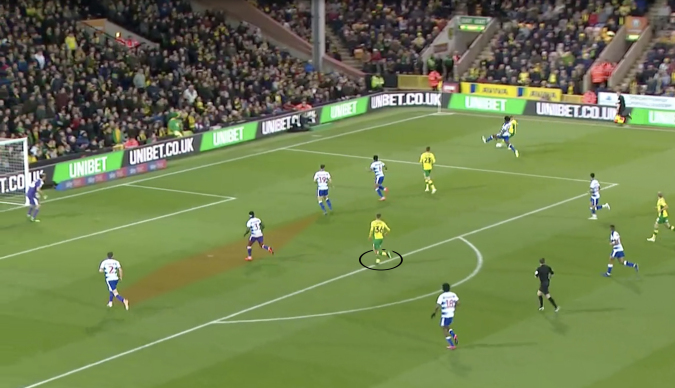
However, there have been signs of subtle improvements. The best examples in his three most recent Premier League matches, where he managed to find himself on the ends of big chances at either post in all of them. The stark contrast in his shooting positions and subsequent shot quality between this season and the last can be seen in his comparative shot maps. Last season, away from cutbacks, he was often shooting from range (mostly from loose balls following corners).

This season he's finding himself in much higher percentage positions and if he can continue to do so it will improve his goalscoring record.
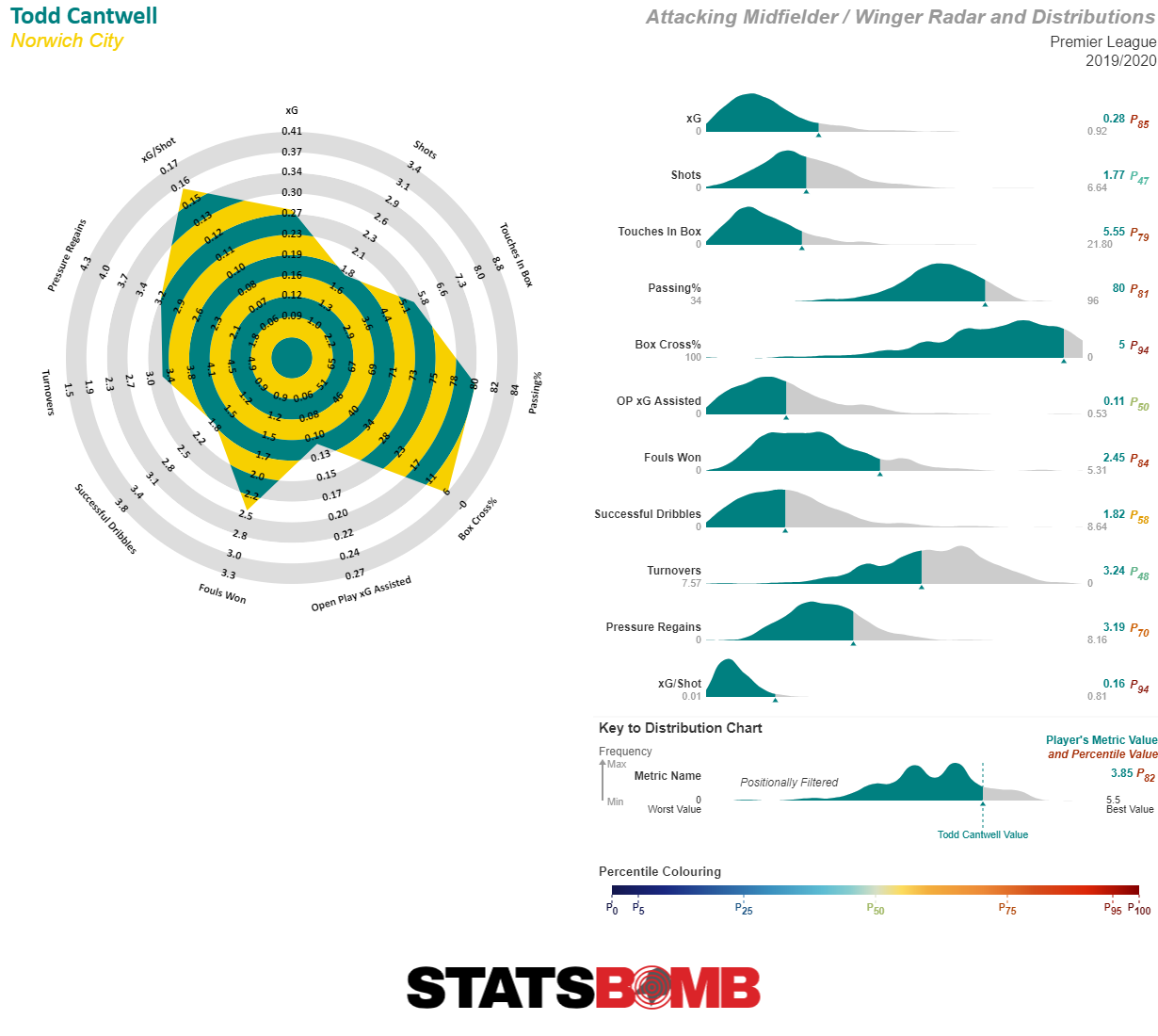
Defensive game
Pressing and counter-pressing
Cantwell isn’t the tireless workhorse of a wide midfielder, that teams hope for these days, but that doesn’t mean he’s always short of intensity.
He boasts a positive level of enthusiasm and a quietly solid level of defensive technique when pressing high up. He reads these situations quite well in order to pounce or sometimes (successfully) slide in on them; he and even shapes his runs and his body to close off different angles. Although the aggression in his counter-press can sometimes giveaway fouls.
Defending in his own third
His defending one-versus-one hasn’t been too bad, either, since his body shape tends to maintain an optimally low stance with a spread figure to enable him to shift quickly to either side.
It’s his flat-footedness, particularly when defending goal-facing, that makes him susceptible to plays like give-and-go’s. And, what doesn’t help his case is his further lack of awareness. Whilst he has some sense of where to block off angles in a high press, his knowledge of how to adjust to what’s around him in his own third is poor. He doesn’t check over his shoulder nearly as much as he should and leaves opponents behind him open as a result.
Conclusion
Last season he was still a fair way from meriting extreme praise but his impeccable adjustment to the Premier League so far deserves acclaim.
So long as Farke continues to give him starts on the left, there is little reason to believe that this hot streak couldn’t transform into a sustained period of reliable goalscoring contributions, such has been the remarkable developments of certain areas of his game this season. Hopefully, as well, we’ll then start to see a freer-roaming Cantwell, who also provides good contributions deep in buildup, just like in 18/19.
In terms of the future, whether or not Norwich stay up this season, Cantwell undoubtedly deserves to remain at this level at the very minimum, but his adaptation into a potentially more rigid side might well raise some questions.
Header image courtesy of the Press Association
